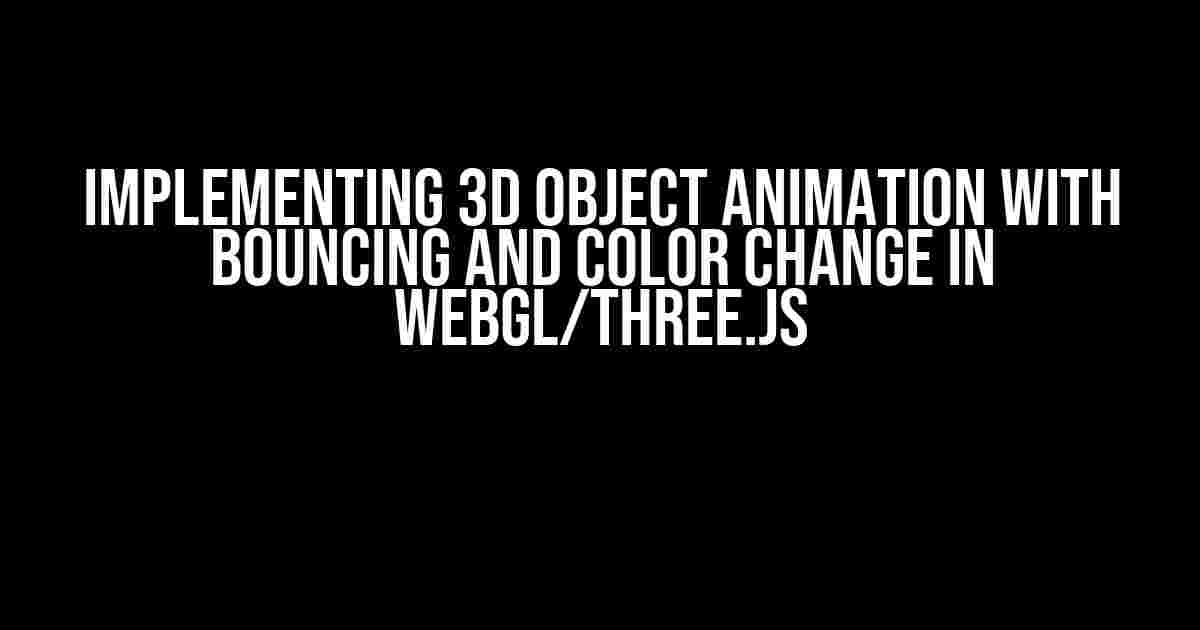WebGL and Three.js have revolutionized the world of 3D graphics on the web, enabling developers to create immersive and engaging experiences for users. One of the most impressive aspects of WebGL and Three.js is the ability to create complex animations that bring 3D objects to life. In this article, we will explore how to implement 3D object animation with bouncing and color change effects using WebGL and Three.js.
Getting Started with Three.js
Before we dive into the animation implementation, let’s quickly cover the basics of setting up a Three.js project. If you’re new to Three.js, you can start by including the library in your HTML file:
<script src="https://cdnjs.cloudflare.com/ajax/libs/three.js/r128/three.min.js"></script>Next, create a scene, camera, and renderer:
const scene = new THREE.Scene();
const camera = new THREE.PerspectiveCamera(75, window.innerWidth / window.innerHeight, 0.1, 1000);
const renderer = new THREE.WebGLRenderer({ canvas: document.getElementById('canvas'), antialias: true });Creating the 3D Object
For this example, we’ll create a simple sphere using the `THREE.SphereGeometry` class:
const geometry = new THREE.SphereGeometry(1, 60, 60);
const material = new THREE.MeshBasicMaterial({ color: 0xffffff });
const sphere = new THREE.Mesh(geometry, material);
scene.add(sphere);Implementing Bouncing Animation
To create a bouncing animation, we’ll use the `THREE.AnimationMixer` class and define a set of keyframe animations:
const mixer = new THREE.AnimationMixer(sphere);
const bounceAnimation = {
'position.y': [
{ value: 0, time: 0 },
{ value: 1, time: 0.5 },
{ value: 0, time: 1 },
]
};
const bounceAction = mixer.clipAction(bounceAnimation);
bounceAction.play();Implementing Color Change Animation
To create a color change animation, we’ll use the `THREE.Color` class and define a set of keyframe animations:
const colorAnimation = {
'material.color': [
{ value: new THREE.Color(0xff0000), time: 0 },
{ value: new THREE.Color(0x00ff00), time: 0.5 },
{ value: new THREE.Color(0x0000ff), time: 1 },
]
};
const colorAction = mixer.clipAction(colorAnimation);
colorAction.play();Combining Animations
To combine the bouncing and color change animations, we can simply add both actions to the animation mixer:
mixer.addAction(bounceAction);
mixer.addAction(colorAction);Rendering the Animation
Finally, we need to render the animation using the `requestAnimationFrame` function:
function animate() {
requestAnimationFrame(animate);
mixer.update(0.01);
renderer.render(scene, camera);
}
animate();Conclusion
In this article, we’ve demonstrated how to implement 3D object animation with bouncing and color change effects using WebGL and Three.js. By combining the power of Three.js with the flexibility of JavaScript, you can create complex and engaging 3D animations that bring your website or application to life.
Remember to explore the Three.js documentation and examples to learn more about the library and its capabilities. Happy coding!
Here are 5 Questions and Answers about “Implementing 3D Object Animation with Bouncing and Color Change in WebGL/Three.js”:
Frequently Asked Question
Get ready to elevate your 3D animation skills with these FAQs about implementing 3D object animation with bouncing and color change in WebGL/Three.js!
What is the best way to implement 3D object animation with bouncing in Three.js?
To implement 3D object animation with bouncing in Three.js, you can use the `TWEEN` library, which allows you to create smooth animations by tweening (or interpolating) between different states. Simply create a `TWEEN.Tween` object, set the animation properties, and then update the animation in your render loop. You can also use Three.js’s built-in animation features, such as the `AnimationMixer` and `AnimationClip` classes.
How do I change the color of a 3D object in Three.js?
To change the color of a 3D object in Three.js, you can simply update the `material.color` property of the object’s material. For example, `mesh.material.color.setHex(0xff0000)` would change the color to red. You can also animate the color change by using the `TWEEN` library or by updating the material color in your render loop.
Can I use physics engines like Physi.js with Three.js to create realistic bouncing animations?
Yes, you can use physics engines like Physi.js with Three.js to create realistic bouncing animations. Physi.js is a popular JavaScript physics engine that can be used with Three.js to simulate real-world physics, including collisions, gravity, and friction. By integrating Physi.js with Three.js, you can create more realistic and interactive 3D animations, including bouncing and colliding objects.
How do I optimize the performance of my 3D animation with bouncing and color change in Three.js?
To optimize the performance of your 3D animation with bouncing and color change in Three.js, make sure to use efficient rendering techniques, such as using instancing, level of detail (LOD), and culling. You can also reduce the polygon count of your 3D models, use texture atlasing, and minimize the number of draw calls. Additionally, consider using Three.js’s built-in performance optimization features, such as the `WebGLRenderer.antialias` property and the `Scene.optimize` method.
Can I use GPU-accelerated effects like particle systems with Three.js to create more realistic animations?
Yes, you can use GPU-accelerated effects like particle systems with Three.js to create more realistic animations. Three.js provides built-in support for GPU-accelerated effects, including particle systems, decals, and post-processing effects. By using these effects, you can create more complex and realistic animations, including explosions, fire, water, and more. Simply use the `THREE.ParticleSystem` class or a third-party library like `THREE.GPUParticleSystem` to create and render particle effects in your Three.js scene.
I hope this helps!

